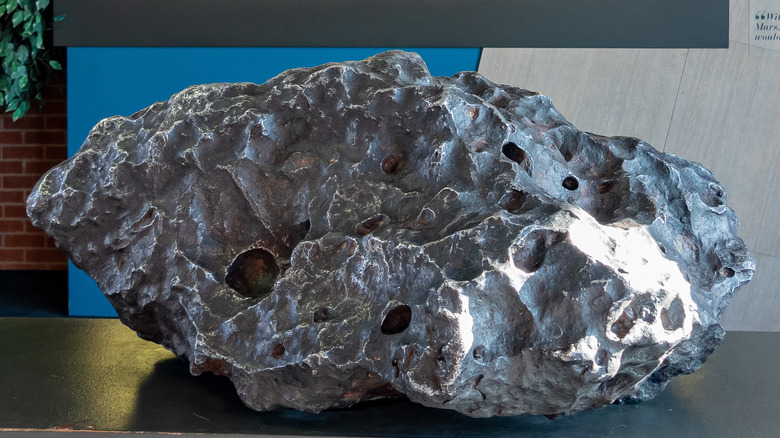The Controversy Behind The Man Who Helped Pioneer Unleaded Gasoline
Until 1996, leaded gasoline was legal in the United States, and it powered cars for much of the 20th century before anyone knew about the hazards caused by lead (via the U.S. Energy Information Administration). After discovering the negative impact that lead had on people's health and on the environment, unleaded gasoline was created. It never would have happened without one man's controversial scientific work, and it changed the future of leaded gasoline in America forever.
People didn't always know that lead was bad for humans. Per Mental Floss, it was considered a godsend in the 1920s, when scientists began adding lead to gasoline. It made car engines run smoothly and quietly, it was inexpensive, and the American public loved it.
But the effects of lead poisoning are devastating, and it only takes a small amount to do lasting damage. Tetraethyl lead, the kind found in gasoline, can cause intense hallucinations and tremors, and can kill a person rapidly just by touching their skin. Lead poisoning in children can cause lifelong problems, like developmental delays, seizures, and learning problems (via Mayo Clinic).
Measuring a meteorite
But despite multiple scientists warning just how bad lead can be for the environment and every living being on the planet, lead poisoning was not taken seriously for decades (via Mental Floss).
Born in 1922 in Iowa, Clair Patterson was always interested in science (via the Iowa Department of Cultural Affairs). Mental Floss reports that Patterson was an exceptionally bright student, and he was recruited to work in a military lab after college. He began to design a mass spectrometer in order to separate isotopes to create enriched uranium. But Patterson's work helped build the Manhattan project's Hiroshima and Nagasaki bombs in the 1940s, turning him away from that line of science for good (via Cosmos Magazine).
Around 1953, Patterson managed to measure the isotopic composition of lead found in a meteorite. His important work proved that the planet Earth was 4.5 billion years old, a groundbreaking discovery.
Finding lead everywhere
After studying the lead levels for his Earth-dating work, Patterson continued to research lead through the 1960s (via CalTech). His methods of detecting four common lead types worked almost too well — because Patterson kept finding lead in literally everything.
He had traveled to California for his studies, and he found lead floating on the surface of the ocean there. He was then shocked to find lead rates were actually 100 times higher at mountain level. Patterson concluded that the atmospheric lead rates in California were at least 1,000 times higher than they should have been. He was so disturbed by the findings that he dedicated the rest of his life to education about the dangers of lead, and trying to eliminate lead from as many products as possible.
He wrote a paper in 1965 titled "Contaminated and Natural Lead Environments of Man" (via Cosmos Magazine). But instead of celebrating the discovery, his paper evoked fury.
Controversial papers
Among Patterson's critics, Robert Kehoe was one of the most formidable (via Mental Floss). His laboratory had monopolized research on tetraethyl lead. But he was being bankrolled by major leaded gasoline companies like DuPont and General Motors, creating a pretty glaring conflict of interest. Some of Patterson's work was also financed by oil companies, but he risked their ire in order to publish his work. He lost his research funding almost immediately. Patterson was dropped by a petroleum institute and the Public Health Service right after the publication.
In 1971, the National Research Council wrote a report for the Environmental Protection Agency about the damaging effects of airborne lead contamination (via NAS Online). Patterson and his work with lead research were completely ignored. But that didn't stop him from advocating for lead removal, and he began to raise public awareness of highly lead-contaminated foods, like tuna fish, in the late 1970s.
Getting the lead out
And scientists weren't the only people who were irritated with Clair Patterson's scientific progress. According to OpenMind BBVA, an evangelist once knocked on Patterson's door to tell him that he was going to hell for his research discoveries.
Per NAS Online, though Patterson did help bring about change, it was slow to materialize. Lead began to be removed from mainstream gasoline supplies in 1973, but wouldn't be completely eliminated for another 14 years after that. Although gasoline was a major contaminator, the public's lead awareness increased over time, so it was also removed from old water pipes and from household paints.
Patterson was also unpopular with other scientists for his hard-line stance on lead poisoning. He argued that lead could be harmful even in the smallest doses. In comparison, Robert Kehoe had spent years covering up high levels of lead in oil company employees by imposing an inaccurate scale of lead harm (via Mental Floss).
Changing the conversation
For example, Kehoe believed that an employee's blood level should not have more than 80 micrograms of lead per deciliter of blood (via Mental Floss). That meant that if the employee had 65 micrograms of lead per deciliter in their blood, they were considered totally unharmed by the lead. Patterson believed that was patently untrue — we now know today that even five micrograms per deciliter is too high for safety — and fought to change the conversation around lead poisoning to reflect the true harm.
Even toward the end of his life, Patterson remained a controversial figure (via the Iowa Department of Cultural Affairs). In the 1980s, disillusioned with the harm that humans have caused the environment, he began writing a book that advocated for population control.
Clair Patterson died in 1995, the same year he was awarded the Tyler Prize for Environmental Achievement. It was a final award for a scientist whose strong beliefs consistently set him apart from the group.





